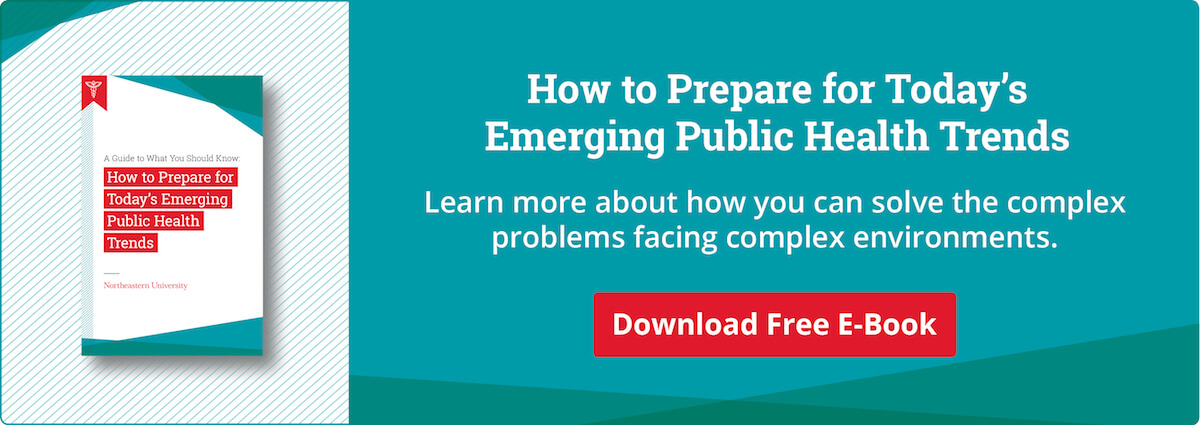Access to adequate healthcare is far from universal, especially in the United States. An 11-country survey conducted in 2016 showed that adults in the U.S. are the most likely to go without necessary care because of cost and accessibility issues. The COVID-19 pandemic has exacerbated this already-large divide. Staggering layoffs have also resulted in the loss of healthcare insurance for many, making proper care even more unaffordable. The pandemic has also highlighted existing issues, such as racial disparities in healthcare. For example, in Chicago, Black citizens account for two-thirds of COVID-19 deaths despite accounting for only one-third of the city’s population.
Health advocacy is one way to address these disparities. Through strategic partnerships, awareness campaigns, and more, dedicated individuals can come together to make effective healthcare a reality for all.
Download Our Free Guide to Preparing for a Career in Public Health
Learn more about how you can solve the complex problems facing complex environments.
What is Health Advocacy?
Health advocacy aims to bridge the gaps within our healthcare systems to ensure that people can access affordable, effective, and high-quality healthcare. These gaps are measured by differences in prevalence, mortality, and other adverse health conditions among specific groups, based on factors like gender, socioeconomic status, or race. Healthcare advocacy can be undertaken as a full-time career or as one element of a traditional healthcare career.
“When we talk about health advocacy, we’re talking about social justice and about working diligently to address critical shortfalls,” says Lysbeth Noyes, adjunct professor at Northeastern University’s Bouvé College of Health Sciences. “It’s about inclusion in health services, which should be available to all people.”
Professionals in this field use legal action, lobbying, demonstrations, writing and enacting policy, and publicity campaigns to move policy forward and bring about change on behalf of community health.
Partnerships—especially with members of the community in which one is trying to create change—are particularly important.
“Problems have a home, and they exist in specific areas of a community,” Noyes says. “No one can be a better informant on that problem than the people who are impacted by it. They’re a resource for data and allies for solutions.”
Healthcare Issues Today
Access and affordability are among the most glaring health disparities in the U.S., according to Noyes. These gaps are often connected to disadvantages experienced because of discrimination based on race, gender, sexual orientation, and even location, with racial and ethnic disparities among the most common.
“Vulnerable populations that first come to mind would be children, minority women, low-income populations, the elderly, people with disabilities, and prisoners,” Noyes says.
These historically marginalized groups often face emotional distress, unaffordable housing, a lack of health literacy, and food insecurity, which may prevent them from seeking out care from a healthcare system that is already difficult to access for most Americans.
The COVID-19 pandemic has both worsened these issues and created new ones. More than 30 million Americans were unemployed in July 2020. Many lost their health insurance and ability to purchase medication along with their jobs, adding to existing problems with the country’s healthcare system.
“The challenges that we’re facing with the pandemic are immense on the local, state, and national level,” Noyes says. “Health disparities are glaring, as we know. Areas that are experiencing extensive poverty are hit especially hard, and those numbers are growing exponentially through the pandemic with people losing their jobs. There’s a lot to be done.”
Careers in Health Advocacy
There are many types of careers in health advocacy for those who want to help address these pressing public health issues. Some pursue advocacy full time, while others incorporate it into related careers.
Full-Time Advocacy
“Health advocacy requires bringing a lot of disciplines to bear at once,” Noyes says. “The career opportunities within it are wide and varied.”
Those who choose to pursue health advocacy full time work in several types of organizations, including:
- Local, state, national, and international governments
- Nonprofits
- Healthcare organizations
- Colleges and universities
- Private foundations
- HMOs
In these roles, a professional’s primary goal is to bring about change through advocacy. They spend significant amounts of time researching issues, developing strategies, and then implementing them in communities.
This work relies heavily on teamwork, and professionals liaise with a wide range of partners such as politicians, community leaders, and other healthcare professionals to enact their advocacy strategies.
Incorporated Advocacy
Advocacy can also be incorporated into a range of healthcare-related roles, such as doctors, nurses, caregivers, and more.
“Almost any health position would lend itself to advocacy for a professional who is tenacious and determined to create change,” Noyes says.
She recommends the following plan of action for professionals interested in any form of health advocacy:
- Notice systems that are not working or are missing, particularly in areas that resonate with you.
- Have a vision of what change looks like.
- Take action: Research the issue and find stakeholders and partners.
- Determine early on how you will evaluate success.
- Stay informed by the community that is most affected by the issue as you work.
- Be committed to enduring change and work with community partners to manifest it.
Noyes encourages anyone in the medical field to look for advocacy opportunities in addition to their day-to-day jobs.
“The challenges we are facing are all incredibly important, and it really requires everyone to be community health advocates on their own behalf.”
Becoming a Strong Health Advocate
Effective health advocates have a strong knowledge of public health systems and concerns, making a master’s in public health a useful degree for those interested in advocacy.
Noyes notes that her graduate seminar on health advocacy is a popular course for MPH students at Northeastern. The course focuses on group advocacy projects of students’ choosing, in which they develop an advocacy plan based on established advocacy tools and best practices. Students speak with community leaders involved with their topic, conduct research, and meet with legal entities, among other partners, before presenting their work. Many students incorporate their advocacy initiatives into their final capstone projects.
“The seminar is directed at public health graduate students, but it’s enriched by students of other disciplines who often join,” Noyes notes.
In addition to advocacy strategies, the course also touches on the history and development of the field, strengths and weaknesses of existing health advocacy programs, and the essential role of partnership.
For more information on how to effect change in your community and beyond, download our ebook below.







Related Articles
4 Pressing Global Health Problems We Face Today
Global Health Careers: How Can I Make a Difference?
Compliance Specialists: Who They Are and What They Earn